To get to his office, one must negotiate a labyrinth of hallways with walls that feature large, locked storage cabinets from floor to ceiling. Invisible to the common visitor, the artifacts and items contained within them constitute only a tiny fraction of the vast collections housed by this, the world’s largest museum complex. Many respectable research scholars would no doubt water at the mouth with the prospect of living and working here. Some of them have already earned the right. One of them is Dr. Dennis Stanford. A soft-spoken man of middle age, he is one of the world’s foremost authorities on Paleo-Americans. When not traveling or conducting field research, he makes his professional home tucked unseen behind the public halls of the Smithsonian Institution’s National Museum of Natural History. Here, he directs the institution’s Paleo-Indian Program, spearheading the Smithsonian’s research efforts into the most ancient peoples and cultures of the American continents.
Offering me the opportunity to see in person what represented the essence of his latest research efforts, he graciously led me through the hallways to his office. It was not the typical vision of a professional office space. We first walk into a spacious room that features a very large table at its center. At first glance, there isn’t much on its surface, but below it are scores of drawers filled with artifact casts and other items related to his research and program responsibilities. Around the walls I could see charts and images displayed, some of which I recognized from the content of his latest book, Across Atlantic Ice, co-authored by University of Exeter archaeologist Bruce A. Bradley and now a bestseller with the University of California Press. He pulls out drawers filled with carefully placed lithic (stone) artifacts and places them on the table. In one of them, he shows me a tray of what appear to be six stone spear or projectile points or knives, placed in horizontal alignment. Each classified as a “bifacial” (worked on both sides) and shaped like a laurel leaf, they are comparatively very similar in size and shape. I hold each in my hand and note that they are relatively thin, lightweight, and finely crafted. Most of them were dredged up in nets by fishermen, found submerged off the eastern coast of the U.S. At first blush, these pieces would not raise any eyebrows, except that one of them, found in 1970 by the crew of the vessel Cinmar while harvesting sea scallops approximately 100 kilometers off the coast of Virginia, was found in association with the remains of a mastodon dated to nearly 23,000 years ago; and another, a nearly identical laurel-leaf-shaped point that appeared as though it was made by the same maker, was actually found in Europe. The latter was a laurel leaf point manufactured by people who had lived from around 22,000 to 17,000 BP in certain regions of what is today France and Spain. They were identified with an advanced, innovative flint tool-making style of the Upper Palaeolithic, known as the Solutrean.
_________________________________________________________________________________________
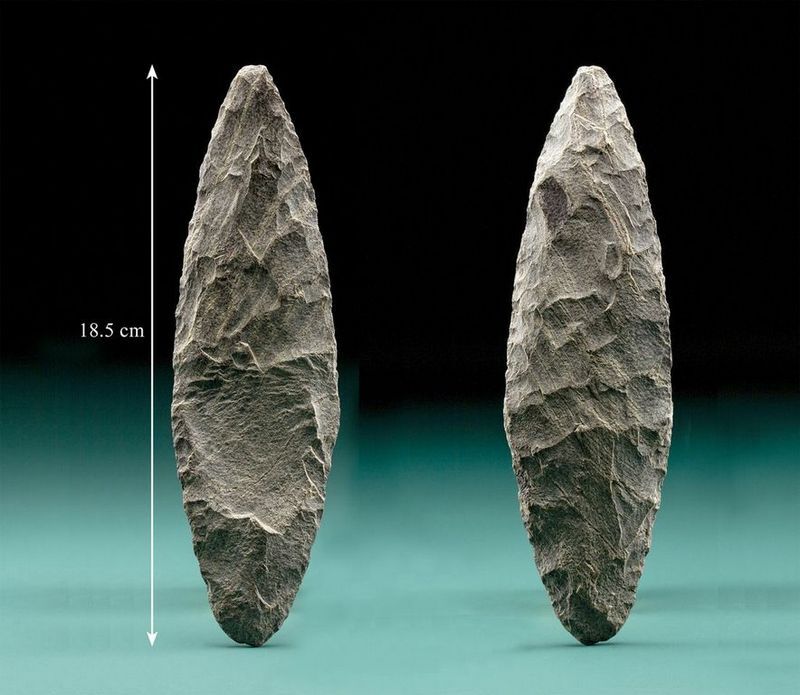 The Solutrean-style laurel leaf biface artifact found at the “Cinmar” site on the submerged continental shelf off the eastern U.S. mid-atlantic coast. Courtesy Dennis Stanford
The Solutrean-style laurel leaf biface artifact found at the “Cinmar” site on the submerged continental shelf off the eastern U.S. mid-atlantic coast. Courtesy Dennis Stanford
_______________________
So what were Solutrean-style points doing off the eastern North American shoreline?
He shows me another tray that holds a cast of another biface laurel leaf projectile point. It was found in the 1970s along with other prehistoric artifacts below a clay chimney base at an archaeological excavation of a 17th century colonial homestead on Eppes Island, Virginia. Analysis of the artifact indicated that it was made out of French flint, a type of material only found in France. Stanford writes about this find in his recent book. “This location would have been an excellent camping locality following the LGM (the Last Glacial Maximum, between 26,000 and 20,000 years ago),” he writes. “The biface and other prehistoric artifacts were found below a clay chimney base and thus were not likely to have been the possessions of a colonist. Because this is not certain, the laurel leaf is not the smoking gun of our theory, but it is an intriguing piece of evidence.”[1]
_________________________________________________________________________________________
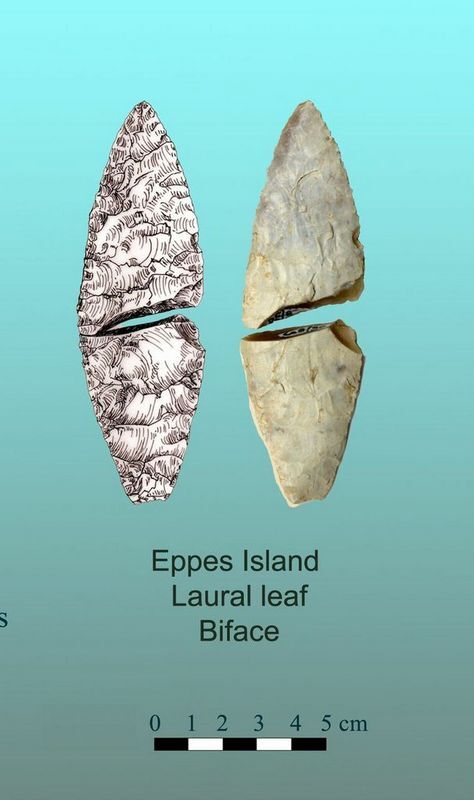 Courtesy Dennis Stanford
Courtesy Dennis Stanford
_________________________________________________________________________________________________________________
One could make a case that the Cinmar and Eppes Island artifacts are inexplicable flukes, but in tray after tray, Stanford shows me casts of stone artifacts from various American sites or deposits dated to pre-Clovis and Clovis times, along with those of the Solutrean culture obtained from the other side of the Atlantic, all exhibiting remarkably similar characteristics.
Stanford suggests a possible historic connection for all of this. He, along with colleague Bradley, hypothesize that sometime between 25,000 and 13,000 years ago, members of the Solutrean culture based in Europe followed their subsistence needs across the ice-edge environment of the Last Glacial Maximum (LGM), taking them across the (then) exposed ice and lands along the northern margins of the North Atlantic between two continents to gradually reach North America as the ancestors of the Clovis peoples, traditionally considered the first clearly defined culture of the Americas. It is known among scholars today as the “Solutrean Hypothesis”.
He admits that his model has faced some stiff resistance, particularly among scholars of the traditional early American “Bering Land Bridge” origins theory. But for at least some of the unconvinced who visit his lab and see and handle the artifacts, seeing is believing. “Those who come in and see the evidence here,” he maintains, “walk away with a more accepting attitude”.
But the road into the mainstream continues to go uphill. Says Margaret “Pegi” Jodry, a long-time research associate who has worked closely with him for many years: “They hold us to a higher standard. It seems unfair, but it is true. If our artifacts were found in the Pacific Northwest, Canada or Alaska, we wouldn’t need to show the same high “burden of proof” to support the traditional Bering Land Bridge theory.”
Challenging the Popular Paradigm
The broadly accepted view about when and how people first entered the Americas has revolved in part around the changes in the glacial periods associated with the last glacial period of the Ice Age, a time when the Cordilleran and Laurentide ice sheets covered much of northern North America. However, during the warmer interglacial periods, they retreated to create ice-free corridors along the Pacific coast and areas east of the Rocky Mountains of Canada. Scientists have long suggested that it was through these corridors that humans were likely able to cross Beringia into the Americas. Beringia was a land bridge as much as 1,000 miles wide that joined present-day Alaska and eastern Siberia at various times 110,000 to 10,000 years ago. Exactly when and how this crossing may have occurred has been a matter of debate for decades, but the most widely accepted proposal advances the suggestion that it may have occurred around 15,000 years ago, giving rise to the Clovis culture.
The Clovis time refers to a time period (beginning about 13,500 years ago) to which, according to many scholars, the earliest known stone tools and weapons made by early ancestral Native Americans could be assigned. Best known for their medium to large fluted lanceolate projectile points and distinctive bone and ivory items, these stone artifact finds constitute the evidential basis for the widely accepted “Clovis First” hypothesis, which suggests that the people associated with the artifacts were the first inhabitants of the Americas. Clovis artifacts have been found in abundance at sites across the North American continent.
But now, new arguments against the traditional Clovis First perspective are emerging, pointing to the fact that no Clovis-type artifacts have been found in Northeast Asia, from where the early Americans under the Clovis Model are suggested to have migrated, and fluted stone points that are iconic for Clovis and found in Alaska are all dated too late to be assigned to the Clovis horizon. Moreover, six major sites in South America with stratigraphic layers dated to the Clovis period are devoid of Clovis period artifacts.
Focusing on the lithic evidence, Dennis agrees with the new arguments.
“Our evaluation of the Beringian data is that there is no [archaeological] evidence of Clovis ancestors in Siberia. The oldest fluted points in Alaska are younger than western Clovis and much younger than the early sites in eastern North America. Even if we discount these dates, there are no good technological candidates for a thinned biface, large blade tradition [hallmark characteristics of Clovis] in Beringia.”[2] Moreover, states Stanford, “there is increasing evidence that a habitable land route through the northwest American ice-free corridor was not available before Clovis times. When a passable corridor did open, the evidence points to people moving northward up the corridor when it opened rather the other way around.”[2]
But looking east toward the eastern half of the U.S., a different story may be emerging — one that could extend all the way to Europe.
The Solutrean Hypothesis
I asked Stanford what initially led him to consider a possible European origin for Clovis.
“There were several things,” he responded. “What they were unearthing at the Cactus Hill site in Virginia, and then what I saw in Europe at exhibits and a Solutrean exhibit in Spain made me think — ‘that looks just like Cactus Hill’! Then I learned that the Cactus Hill artifacts had been radio-carbon dated to 16,000 RCYBP (Radio-Carbon Years Before Present, or 19,200 years ago). That was very exciting.”
And through time, all the pieces, archaeological, paleo-climatological, and geographic, began to come together for him.
New excavations in the southeastern U.S. and the mid-Atlantic were yielding artifacts dated to pre-Clovis times. Sites like Meadowcroft Rock Shelter in Pennsylvania, Cactus Hill in Virginia, Miles Point and Oyster Cove on the Chesapeake Bay, as well as the offshore Cinmar site, to name but a few, all revealed lithic artifacts arguably dated thousands of years before the oldest Clovis points found across North America. And like the Cinmar point and other points uncovered throughout the eastern U.S. and at underwater locations off the eastern seaboard, the Solutrean assemblages found in Europe, and more specifically southwestern France and northeastern Spain, shared remarkably similar characteristics.
“The majority of the oldest dated sites in the Americas with undisputed artifacts are in the Chesapeake Bay region,” maintains Stanford. “The artifacts from these LGM sites are technological and functional equivalents of artifacts from the same period found in southwestern Europe and are not technologically or morphologically related to any east Asian technology.” [3]
_____________________________________________________________________________________________________
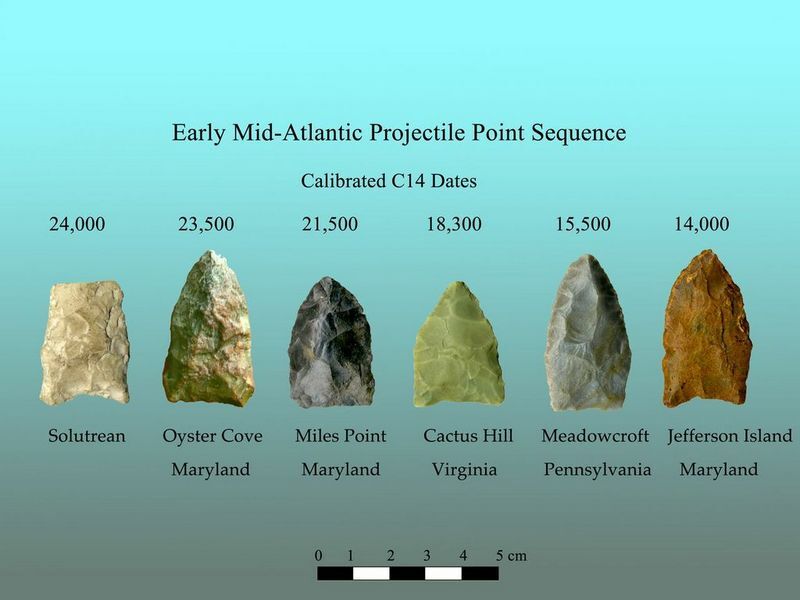 Projectile points and their corresponding ages, found at sites in eastern North America. The first artifact on the far left represents a typical point of the Solutrean type, found in Europe. Courtesy Dennis Stanford
Projectile points and their corresponding ages, found at sites in eastern North America. The first artifact on the far left represents a typical point of the Solutrean type, found in Europe. Courtesy Dennis Stanford
_______________________________________________________________________________________________________________________
 Graphic illustration of indented base points. A is a Solutrean point found in Europe. B is a point found at Cactus Hill in Virginia. Courtesy Dennis Stanford
Graphic illustration of indented base points. A is a Solutrean point found in Europe. B is a point found at Cactus Hill in Virginia. Courtesy Dennis Stanford
______________________________________________________________________________________________________________________
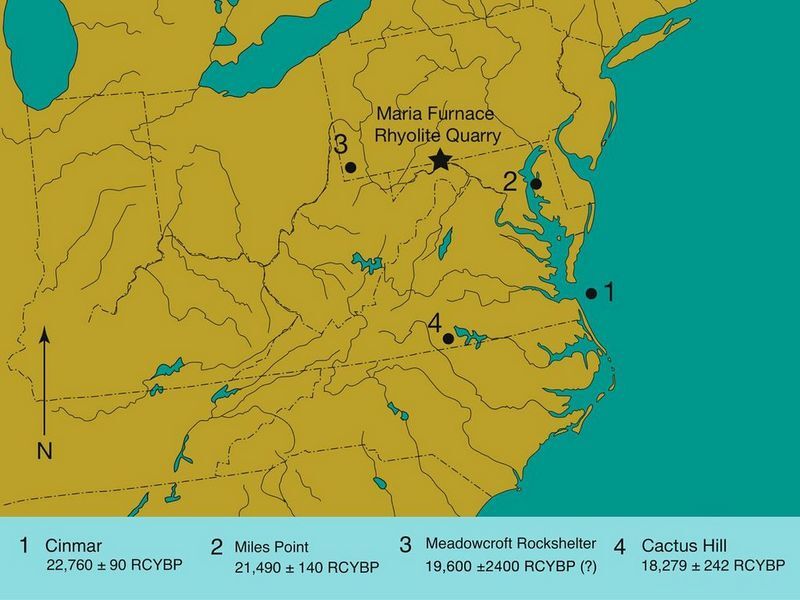 Locations of some of the sites, with dates, bearing pre-Clovis artifacts. Courtesy Dennis Stanford
Locations of some of the sites, with dates, bearing pre-Clovis artifacts. Courtesy Dennis Stanford
_______________________________________________________________________________________________________________________
But as Stanford and Bradley, both expert flintknappers, would point out, it is not all about their appearance. Both Solutrean and Clovis technology, they contend, involved specific and sophisticated methods of manufacturing their end-products, constituting a nearly identical processing technology of highly specific sequential steps. This, they maintain, belies arguments for separate or independent development. “We contend that the more basic a technology, the more likely its independent invention. By the same token, we conclude that complex technologies that shared highly detailed and specific methods were unlikely to have been independently developed. The possibility of their historical relatedness would of course depend on a plausible link in time and space. Since this exists for Solutrean, pre-Clovis, and Clovis, we conclude that the high degree of correspondence between their flaked stone technologies indicates a historical relatedness.” [4]
_____________________________________________________________________________________________________
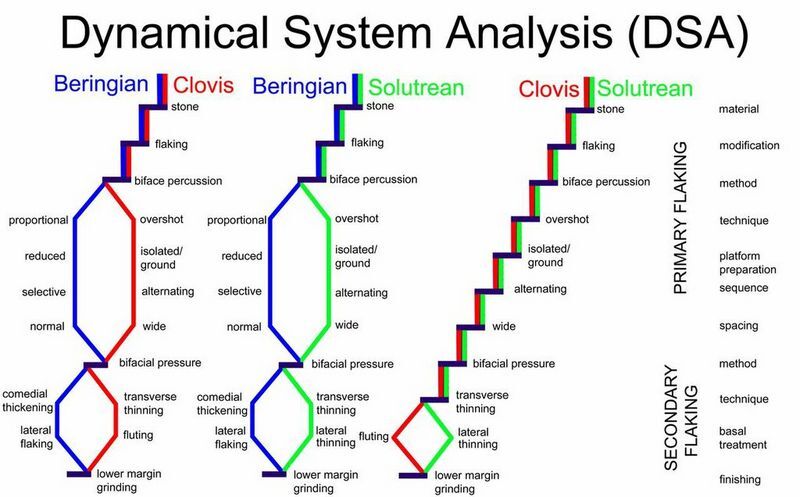
Developed based on cluster analysis, this diagram shows where the stone tool formation processs converges and diverges in comparisons between the Clovis, Beringian, and Solutrean traditions. As can be seen, the Clovis and Solutrean manufacturing processes are remarkably similar, as indicated by the converging elements. Courtesy Dennis Stanford
_______________________________________________________________________________________________________________________
Needless to say, their critics point to a number of problems with the hypothesis. What about the distance, geographic, and climate barriers that make the historical connection implausible? And where were the boats? Where is the evidence for a maritime technology and other technological adaptations necessary to establish such a connection?
The Climate and Geography
Even with the matching technology and the growing evidence for correlation in time between dateable assemblages in America and Europe, would the climatological and geographic conditions that existed over 20,000 years ago in Europe and North America facilitate such a connection?
Stanford and Bradley think so.
Based on recent studies, they assert that the colder, drier conditions during the LGM in Europe likely incentivized animal and human populations to move into more temperate zones. “Pollen records and the increased number of archaeological sites indicate that more favorable conditions existed along the coastal areas of Spain, Portugal, and southwestern France and in the sheltered river bottoms of southwestern France.” [5] Therefore, even though the harsh LGM climate was much colder and drier than today, the “relatively high insulation [from the harsher conditions away from the coast and in the higher elevations inland], ample winter daylight due to a relatively low latitude, and moderate snow cover favored rangeland productivity and supported a reasonable biomass.” [6]
Moreover, the southward-advanced ice edge that marked the southern margins along the North Atlantic in the broad expanse that today encompasses Greenland and Iceland between Europe and North America, due to the lower LGM sea levels, availed a more southerly platform along which Paleolithic peoples may have moved, as compared to today’s conditions.
__________________________________________________________________________________________
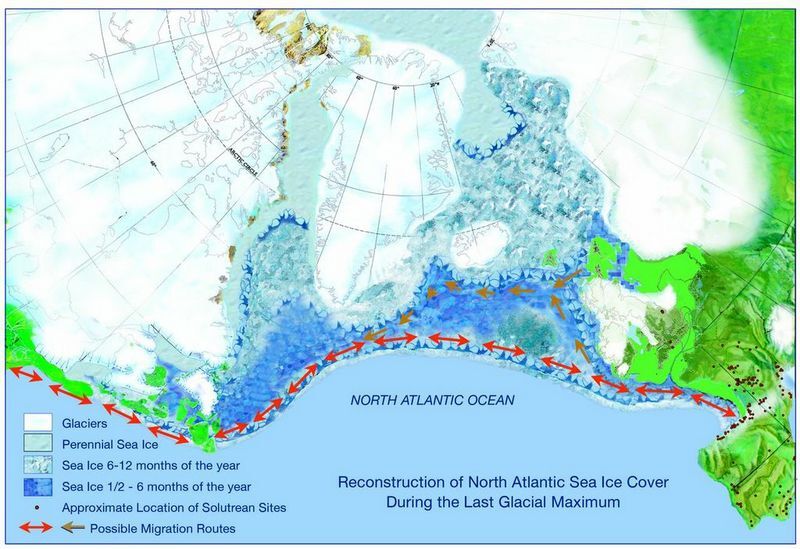 The LGM ice cover in the North Atlantic at the time when Solutrean peoples are hypothesized to have crossed over from Europe to the Americas. Courtesy Dennis Stanford
The LGM ice cover in the North Atlantic at the time when Solutrean peoples are hypothesized to have crossed over from Europe to the Americas. Courtesy Dennis Stanford
_______________________________________________________________________________________________________________________
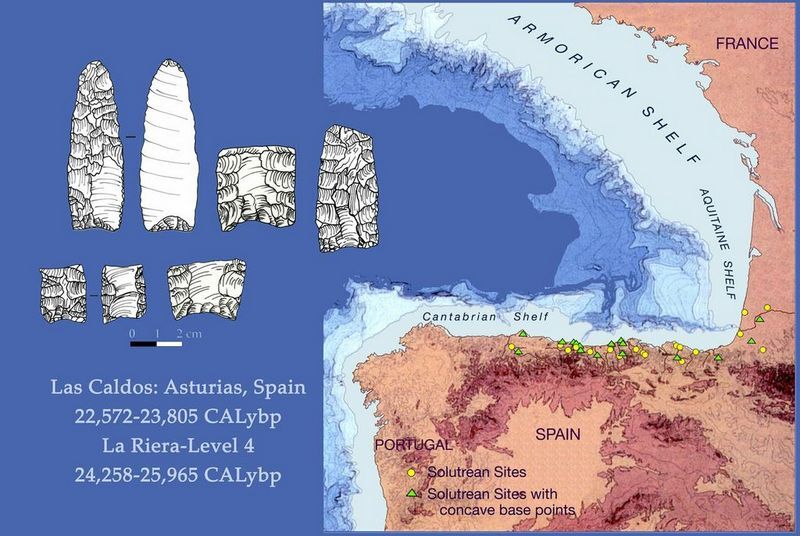 Map showing the exposed continental shelf along southwestern France and northwestern Spain, with known Solutrean sites. Also shown are concave based points from Spain, representing the types of artifacts of the period that show similarities to the Clovis and pre-Clovis artifacts found in eastern North America. Courtesy Dennis Stanford
Map showing the exposed continental shelf along southwestern France and northwestern Spain, with known Solutrean sites. Also shown are concave based points from Spain, representing the types of artifacts of the period that show similarities to the Clovis and pre-Clovis artifacts found in eastern North America. Courtesy Dennis Stanford
________________________________________________________________________________________________________________________
But such a connective route would not necessarily have been easy. “Deep sea cores,” write Stanford and Bradley, “show that the biological productivity beneath the perennial LGM ice was low, perhaps as much as 50 percent less than today, and life ecozones were shifted southward from their present locations to compensate for these harsher physical conditions.” However, they continue, “this low productivity nevertheless would have provided enough resources for the Paleolithic people who made their living from the sea.” [7]
On the other side of the Atlantic, the LGM saw, at times contemporaneous with similar conditions on the European side, an extended North American landmass due to lower sea levels. Much of the submerged continental shelves of today were at that time vast plains that had a mix of pine tundra flora and large mammal fauna, such as mammoth. Indeed, sea dredging and paleoecological analysis of the finds have suggested this to be the case. “The continental shelf would have been above sea level and available for plant and animal colonization from Browns Bank, which fronted an ice-covered Gulf of Maine, southward to the Straights of Florida,” write Stanford and Bradley. “Throughout this distance of some 1,800 kilometers, the shelf was transformed into a wide extension of the coastal plain.” [8]
_______________________________________________________________________________________________________
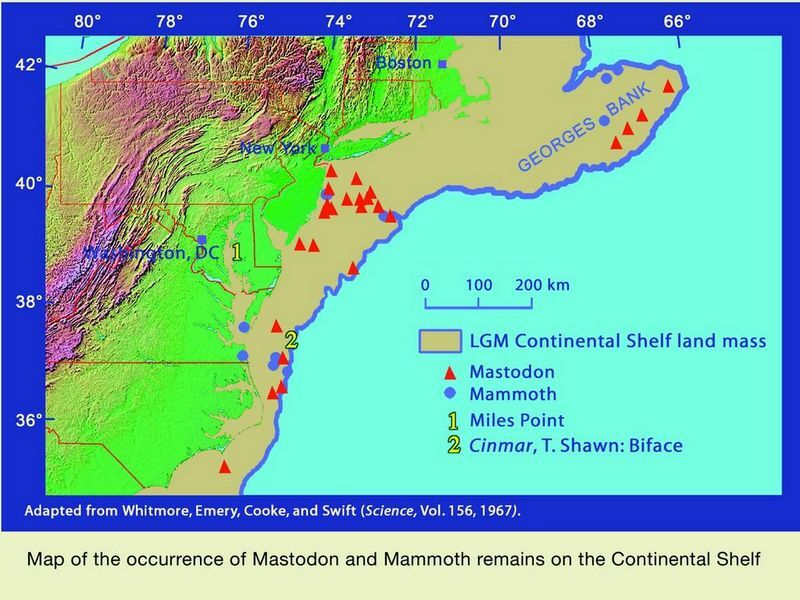 Map showing the extent of the exposed continental shelf during the LGM with large mammal sites. Also shown are two of the key sites where Solutrean-type artifacts were found. Courtesy Dennis Stanford
Map showing the extent of the exposed continental shelf during the LGM with large mammal sites. Also shown are two of the key sites where Solutrean-type artifacts were found. Courtesy Dennis Stanford
_______________________________________________________________________________________________________________________
 Distribution of known Solutrean-style laurel leaf biface artifacts in the mid atlantic coastal and continental shelf areas, showing extent of dry land during the LGM. Courtesy Dennis Stanford
Distribution of known Solutrean-style laurel leaf biface artifacts in the mid atlantic coastal and continental shelf areas, showing extent of dry land during the LGM. Courtesy Dennis Stanford
_______________________________________________________________________________________________________________________
Given what recent studies have suggested about the climate and geography of the LGM, “westward-bound Atlantic mariners could have made landfall on the eastern edge of the Grand Banks,” state Stanford and Bradley. [9]
Could it then be only a small leap of the informed imagination to suggest that artifacts like the Solutrean-style Cinmar laurel leaf point found submerged with a mammoth in the waters of the eastern North American continental shelf, and the Solutrean laurel leaf points of Southwestern France and northwestern Spain, share a common cultural thread?
Solutrean Mariners?
A number of archaeological sites with Solutrean remains have already evidenced exploitation of the sea and coastal areas of southwestern Europe. Although much of the remains that would support a marine and estuarine subsistence lifestyle may still rest submerged in the waters covering the European continental shelf (a landmass that during the key LGM period was above water and dry), some clues have been found at sites inland from the anciently exposed shelf. Faunal assemblages of shellfish, limpet, periwinkle, salmon, trout, and some seal bones have been recovered. At the La Riera Cave on the coastal plain of eastern Asturias in Northern Spain, for example, archaeologists have recovered large amounts of mollusks, a significant amount of fish remains and some seal bones.[10] Depictions of saltwater fish like flounder and halibut have been discovered on cave walls. There is thus some indication that the Solutrean people acquired marine resources, and likely had technology to exploit them.
But where are the boats? Where is the evidence that they had the technological capability of crossing sea and ice over 20,000 years ago?
Stanford and Bradley point to research that indicates, at least indirectly, that humans possessed a sea-faring capacity much earlier than traditionally thought. Archaeological evidence has suggested that many of the far-flung South Pacific islands witnessed human habitation by about 30,000 years ago. There is evidence of watercraft on the eastern shores of Honshu in the East China Sea by at least 30,000 years ago. Calcareous breccia on prehistoric human remains uncovered on the island of Crete in the Mediterranean has been dated to 51,000 years ago (give or take 12,000 years), a time when Crete was not connected to the mainland, suggesting an open sea crossing as the only way to have reached the island. Aurignacian artifacts (ca. 45,000 to 35,000 years ago) have been found at Fontana Nuova di Ragusa in Sicily, an island never connected to the European mainland. There are depictions of deep-sea fish and flightless auks in El Pendo cave on the coast of northern Spain and at Cosquer Cave on the Mediterranean coast of France. And on the other side of the Atlantic, a fluted projectile point was discovered in present-day Vermont in the U.S., determined to have been left on the surface of a former shoreline of the Champlain Sea during the Ice Age. Analysis of the find indicated that it was made of Ramah chert originating from a chert quarry 1,300 kilometers away in a location that could only have been traversed by boat at the time the point was likely manufactured (see image below).
__________________________________________________________________________________________
 Image courtesy Dennis Stanford
Image courtesy Dennis Stanford
_______________________________________________________________________________________________________________________
This is but a partial list of finds and clues that speak to the possibility that watercraft were indeed a part of the Paleolithic repertoire, though it is too soon to draw definitive conclusions. The direct evidence is not yet there, and this would be predictable, as sites that would bear that evidence are likely currently underwater, at locations on surfaces that during the LGM would have been above ground as Paleolithic peoples were traversing the land and making their encampments. But given the developing evidence, as indirect as it may be, Stanford and Bradley still express qualified optimism. “There is no question,” they maintain, “that watercraft-manufacturing technologies were developed during the Paleolithic, but the earliest physical remains of a boat are from a log craft found in Pesse in the Netherlands that is between 9,510 and 10,040 years old.” [11] Still, even this find has pushed back the chronology on boat-making considerably, based on the traditional view.
Looking Forward
I asked Stanford about his future plans for research.
“We’ll be returning this summer to the “Cinmar” point site where the Mastodon was discovered in 1974 with the University of Delaware to continue our exploration of the site. We’ll use remote sensing and attempt to recover more of the bones and also prospect for other sites. We hope to retrieve additional bones for analysis to determine if there are any butchering marks on them.”
Dennis and other scientists will no doubt look more and more to these now hidden, underwater regions off the U.S. eastern seaboard, places where Paleolithic hunter-gatherers may have walked and camped on dry ground perhaps more than 20,000 years ago. Time and more evidence from sites like these and other new sites further inland in the eastern half of the country, as well as elsewhere, may hold additional keys to a time and people long gone, but whose ancestry and origins may represent a much more complex mosaic than traditional paradigms. DNA research, which has already provided biological clues to the Asian connection, including other recent research that hint at a European connection, holds great promise but is no doubt still in its infancy when it comes to establishing conclusive evidence of Native American origins.
Compared to the vast data thus far collected for the Clovis times and later periods, the evidence for pre-Clovis and a Solutrean hypothesis is less robust and not without controversy. But the material data appears to be mounting and the analytical analysis is becoming more sophisticated and reliable through time.
And even if the mounting evidence and analysis lead in time to a general scholarly consensus of support for their hypothesis, Stanford and Bradley want to make sure that potential critics understand at least one thing: The Solutrean Hypothesis is not exclusive.
It “does not necessarily mean,” writes Stanford in his recently published book, Across Atlantic Ice, “that the Clovis people [as defined here as a people whose ancestral roots may have been in Europe] were the ancestors – or the only ancestors – of contemporary Native Americans, and it does not mean that Paleolithic northeast Asians did not also colonize the Americas. It does mean that, in concert with other strands of evidence, that Clovis is part of the rich, complex, and wonderful story of the ebb and flow of people whose descendants are what we call Native Americans.” [12]
________________________
For more detailed information about the Solutrean Hypothesis, interested readers may purchase the book, Across Atlantic Ice, at the University of California Press website, or at Amazon.com.
________________________________
[1] Stanford, Dennis J. and Bradley, Bruce A., Across Atlantic Ice, University of California Press, Berkeley, CA, 2012, p. 110
[2] Ibid., p. 242
[3] Ibid., p. 246
[4] Ibid., p. 241
[5] Ibid., p. 209
[6] Ibid., p. 211
[7] Ibid., p. 217
[8] Ibid., p. 212
[9] Ibid., p. 212
[10] Ibid., p. 190
[11] Ibid., p. 231
[12] Ibid., p. 14
Cover Photo, Top Left: Solutrean tools discovered in France. World Imaging, Wikimedia Commons




